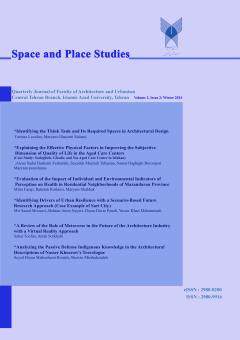Identification of the think tank and its required spaces in architectural design
Subject Areas : ArchitectureMaryam Ghasemi Sichani 1 * , فریناز لوافان 2
1 - Faculty Member, Isfahan (Khorasgan) Branch, Islamic Azad University,Iran
2 - Khurasgan University
Keywords: collective brainstorming, think tank, spatial relationship, spatial design,
Abstract :
In today's world, the imperative for collective brainstorming and idea generation across diverse social, economic, cultural, and political realms is more pronounced than ever. A think tank is a place to achieve this goal and is one of the most important venues for the formation of solutions and strategies for problem-solving in most of the world's developed countries. The necessity of providing knowledge and education, research, industry, and community engagement, as well as cultural and social development for the progress of nations, reminds us of the imperative to establish centers like think tanks. Designing such a building requires defining the main uses of the think tank and its spaces. The questions that arise around the think tank are as follows: What is a think tank, what is its functional use, and what spaces does its building include? In this article, qualitative studies on the design of the think tank and the identification of its spatial features have been conducted. Initially, a definition of the think tank is represented, and then a review of buildings with similar uses in Iran and other countries such as Lincoln and Rand institutions is carried out. Considering the general categorization of spaces into cultural, administrative, and service categories, the introduction of relevant microspaces is addressed. Ultimately, with the study of information obtained from the introduction of spaces, the main diagram of the think tank that should be considered in the design is presented.
آریانپور کاشانی، عباس. آریانپور کاشانی، منوچهر. (1393)، فرهنگ فشردهی انگلیسی به فارسی. تهران: موسسه انتشارات امیرکبیر.
آنتونیادس، آنتونی سی. (1381). بوطیقای معماری (آفرینش در معماری) (ترجمه احمدرضا آی). تهران: سروش (انتشارات صدا و سیما. صفحه 277).
روابط عمومی خانه بیداری.http://www.khanebidari.ir/myapp/current/48 . بازیابی شده در تاریخ 15/4/95.
سازمان کتابخانهها، موزهها و مرکز اسناد آستان قدس رضوی. https://library.razavi.ir . بازیابی شده در تاریخ 23/4/95.
سایت اندیشگاه مشیر. http://moshir.net . بازیابی شده در تاریخ 14/4/95.
شفیعی اردستانی، سها. مظفر، فرهنگ. (1388). اندیشگاه مکانی برای تولید دانش. مجله دانش نما. صفحه 140-132.
شولتز، کریستین نوربرگ. (1388). روح مکان به سوی پدیدار شناسی معماری (ترجمه محمدرضا شیرازی). تهران: رخ داد نو. صفحه 14.
علیزاد گوهری، نغمه. فروزنده، امین. طراحی اندیشگاه با رویکرد مفاهیم معماری ایرانی. (1395). کنفرانس بین المللی مهندسی شهرسازی، عمران و معماری. قم. دانشگاه جامع علمی کاربردی. صفحه 6.
فرهنگی قواقلو، لیلا. متدین، حشمت اله. (1394). ضرورت طراحی اندیشگاه بر پایه فضاهای معماری بومی در ایران. همایش ملی معماری و شهرسازی هویتگرا. مشهد. صفحه 2، 3و 4.
گروت، لیندا. وانگ، دیوید. (1384). روش های تحقیق در معماری. (ترجمه علیرضا عینی فر). تهران: دانشگاه تهران. موسسه انتشارات. صفحه 177.
گروه معماری مارکس بارفیلد. http://www.marksbarfield.com/#/projects/ . بازیابی شده در تاریخ 22/5/95.
گروه معماری کنینگهام. https://www.archdaily.com/801370/pathways-innovation-center-cuningham-group-architecture-plus-moa . بازیابی شده در تاریخ 22/5/95.
گروه طراحی ترنر(طراحی موسسه رند). www.turnerconstruction.com/experience/project/660/rand-corporate-headquarters . بازیابی شده در تاریخ 23/5/95.
مک گان، جیمز ج. (2005). اتاق فکر و مشاوره سیاست در ایالات متحده. موسسه تحقیقات سیاست خارجی. صفحه 3.
مک گان، جیمز ج. (2009). فهرست اندیشگاه. سیاست خارجی. صفحه 82. موسسه بروکینگز. https://www.brookings.edu/about-us . بازیابی شده در تاریخ 28/5/95.
موسسه رند. http://www.rand.org . بازیابی شده در تاریخ 28/5/95.
میرزا امینی، محمدرضا. (1382). اندیشگاه: مفاهیم، انواع، روندها، ساختار. تهران: انتشارات دانشگاه شریف. صفحه 2.
ویور، ر. کنت. (1989). انتشارات علوم سیاسی و سیاست. صفحه 566.

